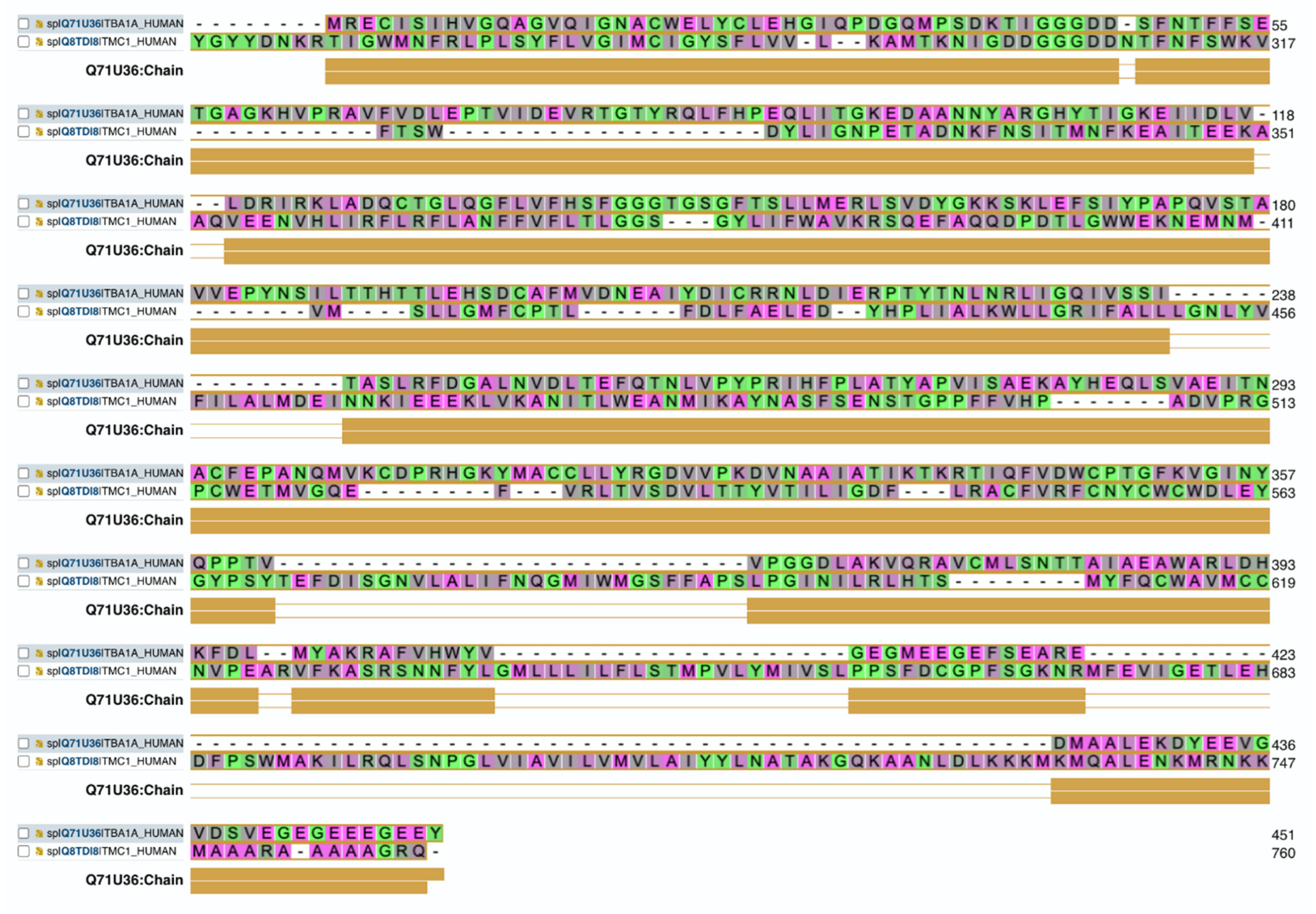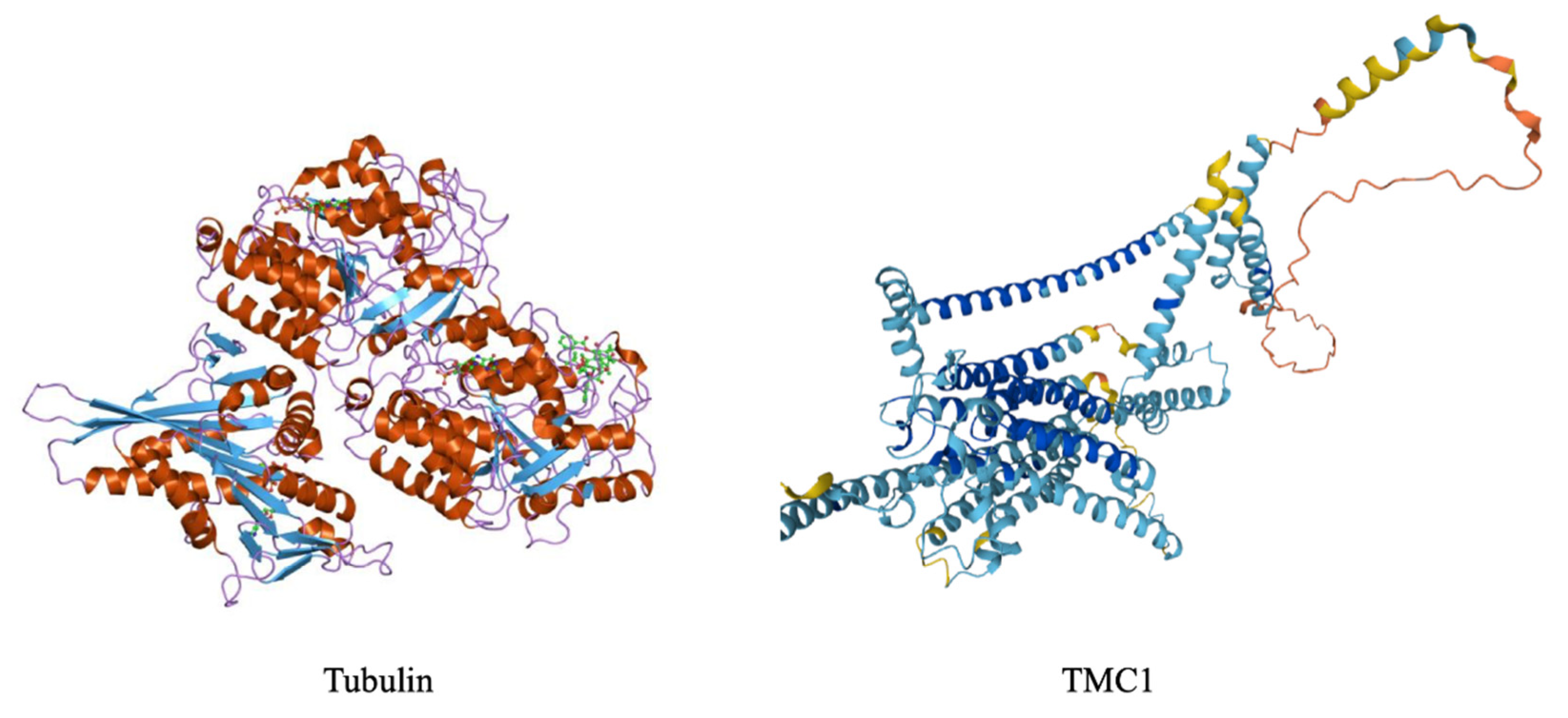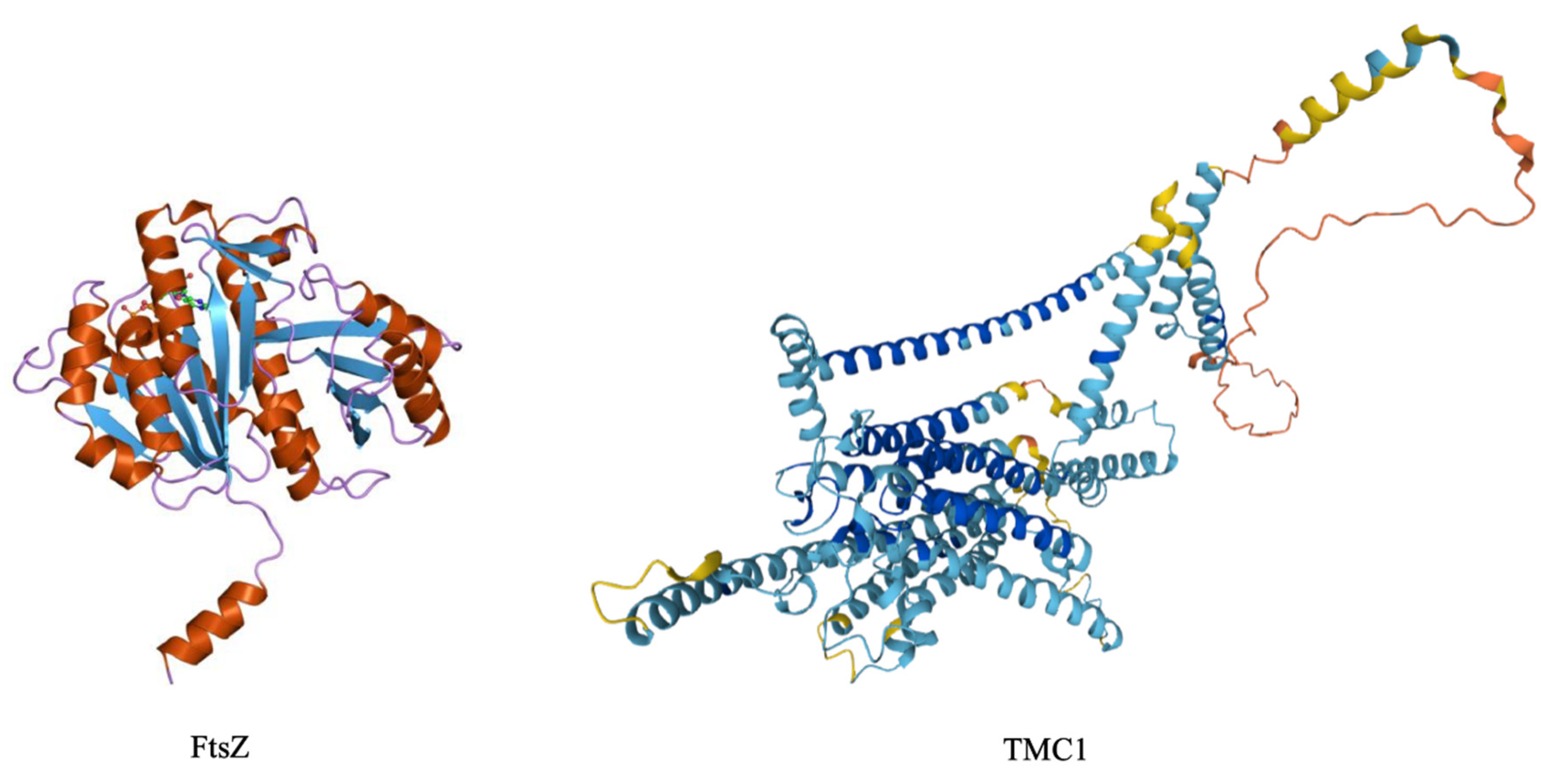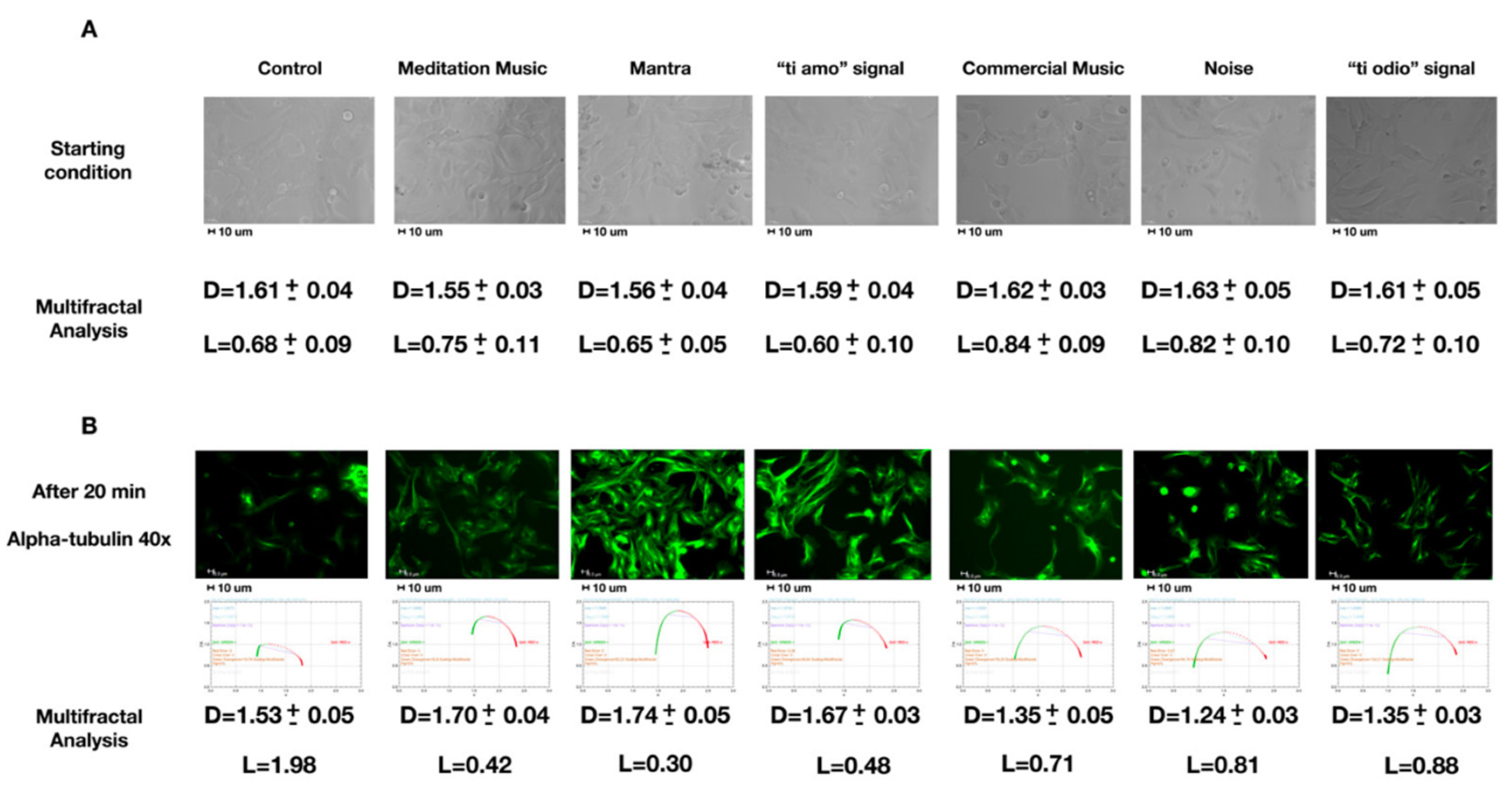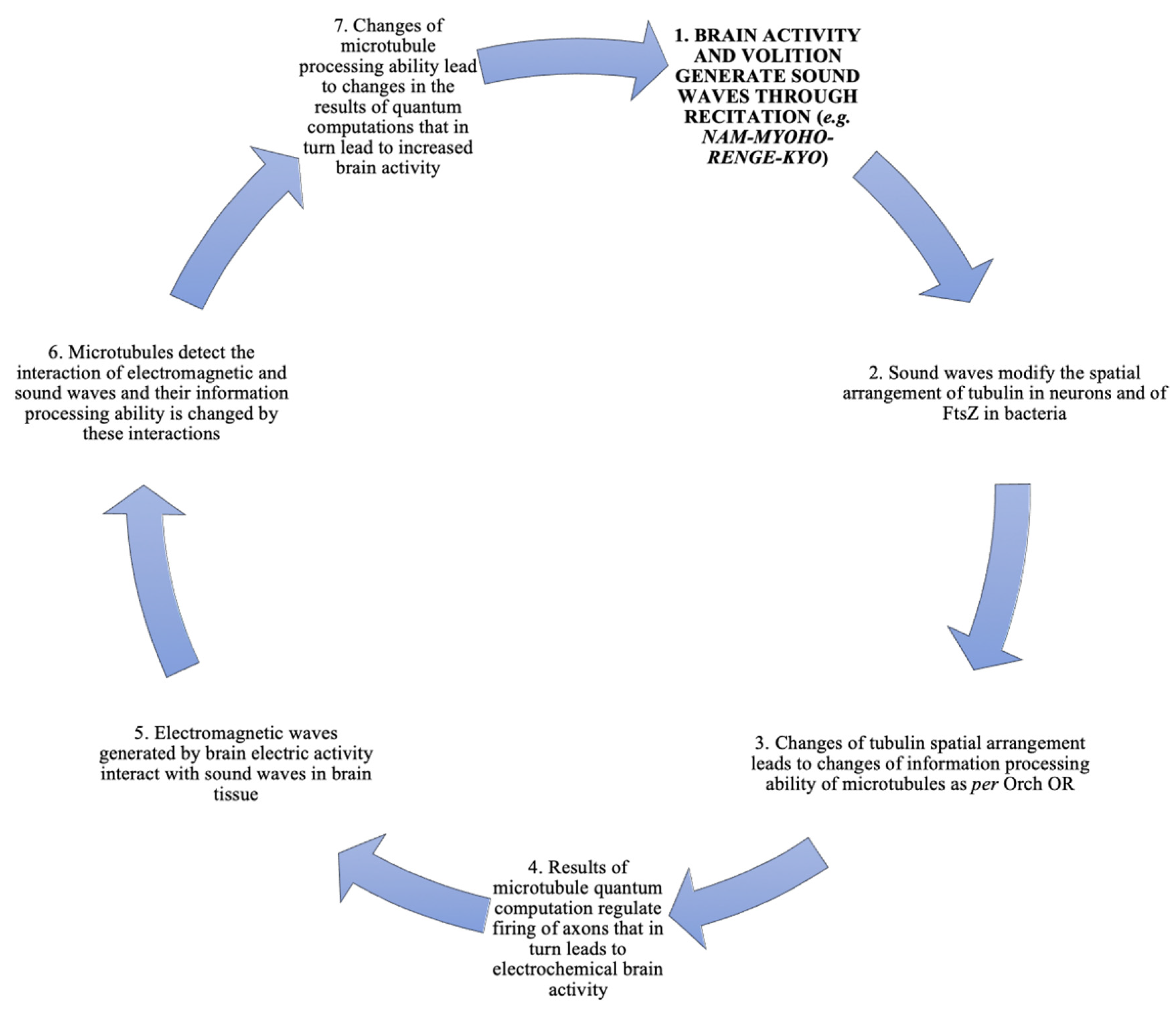Introduction
The Orch OR (Orchestrated Objective Reduction) theory of consciousness postulates that consciousness arises as a result of quantum computations occurring inside brain neurons, more precisely in microtubules that are structures of the cytoskeleton constituted by the protein tubulin (Hameroff and Penrose 2014). At the molecular level, microtubule information processing is hypothesized to be dependent on the presence of aromatic amino acids (tyrosine, tryptophan, and phenylalanine) in the helical structure of tubulin. Aromatic amino acids are characterized by ‘π’ orbital electron resonance clouds in indole and phenyl rings; these orbital clouds are made of electrons that are able to delocalize across a spatial region and would be responsible for quantum computations (Hameroff and Penrose 2014). Microtubules resonate in response to sound waves with frequencies ranging between 12 kHz and 30 MHz, that are frequencies in the range for diagnostic ultrasounds; it was hypothesized that these resonant frequencies could explain the effects of transcranial ultrasounds on mental states (Hameroff et al. 2013). Such an hypothesis received indirect confirmation by the observation that diagnostic ultrasounds at 12 MHz elicited changes in the cytoskeleton of human neuronal cells in culture; in ultrasound-treated cells, the number of elongations, as well as their maximum and mean lengths, increased significantly in comparison with control, untreated cells. In addition, ultrasounds induced cell differentiation affecting cell morphology, as well as the ability of neurons to form complex networks (Bocchi et al. 2015). Further studies demonstrated that diagnostic ultrasounds did not interfere with neuronal mitochondrial activity or protein folding (Branca et al. 2018).
If microtubules respond to sound frequencies in the range for ultrasounds, recent observations seem to indicate that tubulin responds also to sounds in the range for audible since it was demonstrated that audible sound stimuli changed the average fractal dimension and lacunarity of alpha-tubulin in the cultured murine cardiac muscle cell line HL1 (Dal Lin et al. 2021). Therefore, it may be hypothesized that audible sounds, just as ultrasounds, may affect mental states by acting on tubulin in the context of the microtubules of neurons. In order to prove this hypothesis, the sequence and structure of tubulin and of its bacterial counterpart, FtsZ (Filamenting temperature-sensitive mutant Z), were compared with those of TMC1 (Transmembrane channel-like protein 1) a sound-sensitive protein that is responsible for forming the pore of mechanosensory transduction channels in the hair cells of the inner ear of vertebrates (Pan et al. 2018).
The rationale for including FtsZ lays in the observation that microbes show the attribute of intelligent behavior (Sherrington 1951) and consciousness (Reddy and Pereira 2017). Such a microbial consciousness derives from quantum-mediated computations in cytoskeletal structures, that is in a manner superimposable to that described by Orch OR (Reddy and Pereira 2017). Since there exists a brain microbiome (Branton et al. 2013; Ruggiero 2016; Servick 2018; Roberts et al. 2018) where microbes live in symbiosis with neurons and glial cells, it is conceivable that microbes contribute to human consciousness in many ways that comprise participation in Orch OR (Ruggiero 2021).
Study of Sequences and Structures of Alpha-Tubulins and TMC1
Sequences and structures of proteins were studied using the database UniProt and, more specifically, the function designated "align" (UniProt Consortium 2023).
Since the results on audible sounds and alpha tubulin were obtained in murine cells (Dal Lin
et al. 2021), as a first step it was necessary to assess whether murine and human alpha-tubulin shared homologies.
Figure 1, shows that murine and human alpha-tubulin are 100% identical.
Since such an identity extends to aromatic amino acids, it may be deduced that the information processing ability of murine tubulin is identical to that of human tubulin and, therefore, that the results described by Dal Lin et al. (2021), may be extrapolated to humans.
The following step was to establish whether human tubulin shares homologies with TMC1, a protein that is known to transduce audible sounds (Pan
et al. 2018).
Figure 2, shows that the sequence homology of human TMC1 and human tubulin alpha 1A chain is scarce, with only 17.31% identity.
A higher degree of similarity can be observed in the presence of aromatic amino acids (
Figure 3) as well as in the propensity to form alpha-helices (
Figure 4) that are the amino acids and the secondary protein structures where, according to Orch OR (Hameroff and Penrose 2014), information processing occurs.
It should be noticed that both proteins show a secondary structure that is typical for proteins participating in the formation of supramolecular cylindrical structures with an inner cavity (microtubules for tubulin; pores for TMC1).
Figure 5, shows the comparison between the secondary structures of tubulin and TMC1; the alpha-helices positioned external to the beta-sheets are well visible.
Based on these results, it may be hypothesized that the response of tubulin to audible sounds, as reported by Dal Lin et al. (2021), is mediated by the external alpha-helices as it occurs in TMC1; consequently, the changes in the spatial morphology of tubulin has to be associated with changes of information processing via aromatic amino acids and, therefore, with changes of consciousness, mental states or brain activity as it occurs with exposure to ultrasounds (Hameroff et al. 2013; Klinghardt, and Ruggiero 2017).
Study of Sequences and Structures of Human TMC1 and Bacterial FtsZ
It is well assessed that bacterial FtsZ is related to tubulin of eukaryotes (RayChaudhuri and Park 1992); actually, this was the first observation that bacteria have homologs of proteins typical of the eukaryotic cytoskeleton. Since bacteria emit and respond to audible sounds (Matsuhashi et al. 1998) and their "intelligent" behavior is influenced by sound (Shaobin et al. 2010), the sequence and the structure of FtsZ were compared with those of human TMC1. The rationale for this comparison lays in the consideration that if FtsZ, being a homolog of tubulin, may be responsible for microbial consciousness, and if sound affects bacterial behavior, and hence, consciousness, it is possible that FtsZ has sequences, or structures, able to be modified by sound.
The sequence homology of human TMC1 and cell division protein FtsZ from Lactobacillus johnsonii, a probiotic bacterium (Anwar
et al. 2008) is moderate with 23.40% identity, however higher than that obtained by comparing human TMC1 and tubulin (see
Figure 2). Helix propensity is significant in the region comprising amino acids 18-195 of human TMC1 (
Figure 6).
In the region comprising amino acids 18-515 of human TMC1, five aromatic amino acid alignments were observed; however, the overall presence of aromatic amino acids in FtsZ is scarce (
Figure 7). If information processing in cytoskeletal structures depends on aromatic amino acids (Hameroff and Penrose 2014), then the computational power of prokaryotes, or at least that of this Lactobacillus, appears to be lower than that of eukaryotes.
Figure 8, shows the comparison between the structures of FtsZ and TMC1; the alpha-helices positioned external to the beta-sheets are well visible.
Based on these results, it may be hypothesized that bacterial FtsZ, in analogy with tubulin, responds to audible stimuli, possibly through mechanical vibration of the external helices.
Study of Sound Analysis Used to Evoke Tubulin Responses
In the study of Dal Lin
et al. (2021) the murine atrial cardiomyocyte cell line HL1 was stimulated with a series of audible sounds for 20 min and tubulin behavior was studied by immunofluorescence. Among the different stimuli, a meditative phoneme of two syllables (mantra) induced the greatest increase in average fractal dimension and the greatest decrease of lacunarity (
Figure 9).
Figure 10, shows comparison of sound analysis of the phoneme of two syllables (mantra, left panel) used by Dal Lin
et al. (2021) with the hexameter chant (
Nam-Myoho-Renge-Kyo; right panel) that has been studied for its association with psychological resources (Giannini
et al. 2018; Bragazzi
et al. 2019), and its effects on electrolytes (Hiratsuka and Wakae 2019; Hiratsuka and Imamura 2020).
Discussion
It has been known since antiquity that sounds affect human mental states and physiology; several studies have described the neurophysiological responses to different types of sounds ranging from recitation of the Odissey (Cysarz et al. 2004) to religious chanting (Gao et al. 2019). However, just as it happens for murine cardiomyocytes in vitro (Dal Lin et al. 2021), different types of sounds elicit different responses. For example, recitation of Homer's Odyssey translated in German, a language that maintains the original hexametric pace of the verse that is six feet, or rhythmic units, per line, leads to synchronization of heart rate and respiration (Cysarz et al. 2004) up to the point that it is being proposed in the context of the Anthroposophical Therapeutic Speech; this is an approach aiming at the optimization of physiological processes through synchronization of heart rate and respiration, and rebalancing of the sympathovagal equilibrium (von Bonin et al. 2009). On the other hand, Buddhist religious chanting induces functional changes in the brain that are not ascribable to changes of respiratory or cardiac activity, nor to the implicit processing of language; these changes appear to be different from those induced by meditation or prayer (Gao et al. 2019). It is worth noticing that the religious/spiritual dimension has a significant impact on the state of mind (Dick et al. 2014; Hoto et al. 2022) and such a dimension, or the absence of it, might explain the differences observed by Gao et al. (2019).
The spiritual dimension in reciting an hexameter in the context of religious experience pertains to the chanting of Nam-Myoho-Renge-Kyo, a practice that originated in Japan in 1253 and is now carried out on a daily basis by millions of followers of Nichiren Daishonin's Buddhism all over the world. The word Nam derives from the Sanskrit word namas and means "devotion". Myoho-Renge-Kyo is the title of the Lotus Sutra in Japanese (The Major Writings 1979a; Watson, 1993; Giannini et al. 2018; Bragazzi et al. 2019). A simplified translation in English could be "Devotion to the Mystic Law of the Lotus Sutra".
The psychological aspects associated with the assiduous practice of Nichiren Daishonin's Buddhism have been published in a few studies. A study published in 2018 (Giannini et al. 2018) compared the psychological resources of 60 practitioners of Nichiren Daishonin's Buddhism, the most widespread branch of Buddhism in Italy, with those of non-practicing Roman Catholic Church believers and those of Atheists. It was observed that those who assiduously chanted Nam-Myoho-Renge-Kyo and practiced within a community of believers had higher optimism than both Catholics and Atheists. Practitioners of Nichiren Daishonin's Buddhism also showed higher self-efficacy and self-esteem than Catholics and higher perceived social support than Atheists. As far as global personality factors were concerned, Buddhists were more extraverted than the other groups, and they appeared less tough-minded than Catholics. Significant differences were also observed in primary personality factors. Having observed no differences between Catholics and Atheists, the Authors concluded that what is determinant for the greater psychological resources of Buddhists, is the religious practice, that is the assiduous chanting of Nam-Myoho-Renge-Kyo and practice within a community of believers. Another study published in 2019 (Bragazzi et al. 2019), was conducted on 391 practitioners of Nichiren Daishonin's Buddhism in Italy; the results were consistent with those of the previous study. Buddhist subjects made use of adaptive coping strategies, had a predominant internal locus of control, and showed a low psychopathological profile when compared with the normative standard scores.
As far as the actual practice of Nichiren Daishonin's Buddhism is concerned, believers recite aloud (not silently) Nam-Myoho-Renge-Kyo for several minutes every day while performing a liturgy that is called Gongyo, a word originated in ancient China that can be translated as "assiduous practice". During chanting, believers keep their eyes open focusing on the object of worship as per the liturgy of Nichiren Shoshu. They typically repeat Nam-Myoho-Renge-Kyo approximately 15-20 times every breath with a frequency of approximately 3-4 respiratory cycles per minute with rapid inspirations and prolonged exhalations during chanting. Chanting Nam-Myoho-Renge-Kyo with a breathing pattern characterized by rapid inspirations and prolonged exhalations may have significant consequences on brain physiology at the light of the results reported by Dal Lin et al. (2021) and in the context of Orch OR. For example, it was demonstrated that the thickness and the water content of the brain cortex and the meninges vary with inspiration and exhalation; during exhalation, the thickness and the water content are greater (Ruggiero et al. 2013; Bradstreet et al. 2014; Ruggiero 2022).
Figure 11, reproduced below from Ruggiero
et al. (2013), shows the changes of thickness and water content of brain cortex and meninges with inspiration and exhalation
Therefore, during prolonged exhalation, as it occurs in Nam-Myoho-Renge-Kyo chanting, the sound waves generated by chanting take a longer time to travel through areas of the brain that have a greater content in water in comparison with the same areas during inspiration. Since sound waves are known to modulate the expression of a number of genes in eukaryotic cells (Kumeta et al. 2018), and are also able to alleviate chemical stress in microbial cells (Shaobin et al. 2010), it may be hypothesized that the greater thickness and content of water give more time to the sound waves to exert their beneficial effects (Bartel and Mosabbir, 2021) on the human cells of the brain as well as on the microbial cells of the brain microbiota (Branton et al. 2013; Ruggiero, 2016; Servick 2018; Roberts et al. 2018). In addition, chanting is associated with increase in blood flow in the prefrontal cortex (Ruggiero 2023), and this would also contribute to the increase in water content, thus further favoring the effects of the sound waves on the human and microbial cells of the brain. It may be worth considering in this context that microbial cells are particularly represented in the prefrontal cortex as well as in other critical areas of the human brain such as the hippocampus and the substantia nigra (Roberts et al. 2018) where they may play roles not less significant than those played by neurons or glial cells. For example, it was proposed that the properties of the brain microbiota could be integrated in the Orch OR theory of consciousness, thus expanding its explanatory and predictive powers (Ruggiero, 2021). It should also be considered that microbes exhibit the attributes of consciousness and the molecular mechanisms responsible for microbial consciousness are the same that are at the basis of human consciousness (Reddy and Pereira 2017). Therefore, it is not implausible to hypothesize that recitation of Nam-Myoho-Renge-Kyo acts not only on human cells but also on the cells of the human microbiota whether they are located in the brain or elsewhere. In microbial cells such an action may be mediated by FtsZ thanks to its homology with tubulin and its structural similarity with TMC1 as described above. It is interesting to notice that such a concept is not in contradiction with Buddhism. In a writing of Nichiren Daishonin of 1255 is written Life at each moment encompasses both body and spirit and both self and environment of all sentient beings in every condition of life as well as all insentient beings in every condition of life, as well as insentient beings - plants, sky, and earth, on down to the most minute particles of dust. Life at each moment permeates the universe and is revealed in all phenomena (The Major Writings 1979b). These words are significantly reminiscent of the words written 758 years later by Nobel Laureate Sir Roger Penrose and Professor Stuart Hameroff ... there is a connection between the brain's biomolecular processes and the basic structure of the universe. ... We conclude that consciousness plays an intrinsic role in the universe (Hameroff and Penrose 2014).
The role of sound in explaining some of the effects observed when chanting is further supported by the observation that vocalization of
Nam-Myoho-Renge-Kyo is associated with a sound at 116 Hz (Stephen 2018; Stanley 2001; Hiratsuka and Wakar 2019) as well as with the so-called Solfeggio frequencies ( (
Figure 10). The low-frequency sound at 116 Hz is perceived by the Buddhist practitioner as a continuous humming that accompanies chanting. The frequency at 116 Hz is particularly interesting because of its interactions with water that contains electrolytes. These interactions are so effective that this frequency has been proposed as a tool for water purification and desalinization (Hiratsuka and Wakae 2019; Hiratsuka and Imamura 2020). It could be therefore hypothesized that changes in electrolyte composition in the aqueous environment of the brain, with particular reference to decrease of chloride ions, as result of interaction with a 116 Hz sound (Hiratsuka and Imamura 2020), occur during chanting of
Nam-Myoho-Renge-Kyo with consequent changes of cell depolarization patterns and synaptic transmission. The Solfeggio frequencies associated with chanting, on the other hand, may be responsible for a series of biological effects that may help explaining the increase in psychological resources described by Giannini
et al. (2018), and Bragazzi
et al. (2019). It has been demonstrated that these frequencies have a positive impact on the human endocrine and autonomous nervous system (Akimoto
et al. 2018) and improve survival of human brain astrocytes
in vitro (Babayi and Riazi 2017). It appears that the positive effects of these frequencies, however, are not limited to humans since it has been demonstrated that they decrease anxiety in rats (Babayi and Riazi 2019) and reverse cognitive and endocrine deficits in zebra fish (Dos Santos
et al. 2023), thus indirectly confirming the hypothesis enunciated above that recitation of
Nam-Myoho-Renge-Kyo acts not only on human cells.
It should also be considered that the increase in brain activity occurring during chanting, as it is reflected by the increase in psychological resources (Giannini
et al. 2018; Brigazzi
et al. 2019), is associated with changes of the brain electromagnetic field, a field that can be measured by magnetoencephalography (Singh 2014) and is presumed to be able to transmit information (Hosseini 2021). In fact, the increase in blood flow in the prefrontal cortex associated with the increase of synaptic activity and with the changes in electrolyte composition due to the sound waves, might generate an unique pattern of change of the brain electromagnetic field. The concept of an electromagnetic field emanating from the forehead is well known in the Buddhist tradition; in the Lotus Sutra is described how Shakyamuni Buddha emitted a ray of light from his forehead. Since it has been recently demonstrated that humans have indeed the ability to perceive magnetic fields as weak as the earth magnetic field
via a quantum mechanical magnetoreception mechanism (Wang
et al. 2019; Chae
et al. 2022), could it be that the imaginative description of the Lotus Sutra actually reflected an electromagnetic event originating from the brain? And, could it be that these changes of the brain electromagnetic field allow connection with the intrinsic consciousness of the universe as proposed by Penrose and Hameroff (2014)? The hypothesis is all the more intriguing if we consider that although sound waves cannot directly interact with electromagnetic waves, when they both share a common medium, and that medium has electrical properties that vary with mechanical strain, as it is exactly what happens in the brain as also demonstrated in
Figure 11 and in Ruggiero
et al. (2014), the two undulatory phenomena actually interact. As a matter of fact, opto-acoustical devices for medical imaging (Ntziachristos and Razansky 2013) or the technique called "chirp" for enhancing radar performance, utilize the interaction of sound and electromagnetic waves. From a theoretical standpoint, microtubules could be considered a sort of resonant cavity filled with a piezoelectric material,
e.g. proteins (Yuan
et al. 2019; Dixit and Petry 2018). Resonant standing waves, either electromagnetic or acoustical, will then produce fixed patterns of electromagnetic or acoustic properties in microtubules (Bisson 2013). In other words, according to this hypothesis, microtubules would work as Fabry-Pérot interferometers able to detect and interpret, in the context of Orch OR, the interaction of sound and electromagnetic waves. It is therefore plausible that the electromagnetic and sound waves generated during recitation of
Nam-Myoho-Renge-Kyo interact with each other in the context of microtubules and are interpreted by the information processing machinery of the microtubules, ultimately contributing to changes in the level of consciousness associated with the increase of psychological resources observed in the Italian Buddhist practitioners (Giannini
et al. 2018; Brigazzi
et al. 2019). The interaction of the sound waves generated while chanting with the electromagnetic waves generated by brain activity therefore leads to an electromagnetic/vibrational signature that is unique for each type of chanting or recitation. In other words, even assuming that the chanting of different mantras such as
OM (Hoto
et al. 2022) or
Saa Taa Naa Maa (Khalsa
et al. 2009), or the recitation of Greek Hexametric verses (Cysarz
et al. 2004), might activate the same areas of the brain, nevertheless since the sound generated by the vocalization of each mantra/recitation is different, the signature of each electromagnetic/vibrational interaction and its effects on human, or microbial, cells are different and not interchangeable. For example, recitation of
Nam-Myoho-Renge-Kyo produces results different from those deriving from recitation of other mantras or prayers or recitation of the Odyssey. To this point, the author wishes to clarify that the present study has no pretension of comparing different approaches to meditation nor different religions. More importantly, it has no pretension of trying to reduce a highly regarded religious practice such as Nichiren Daishonin's Buddhism to neurophysiological mechanisms operating in the brain or elsewhere. The religious and spiritual experience of practicing Buddhism and chanting
Nam-Myoho-Renge-Kyo goes well beyond brain activity, neurotransmitters or quantum phenomena of consciousness; it encompasses a mystic dimension that, although not in contradiction with science, can't be explained solely by science. Nevertheless, Nichiren Daishonin's Buddhism states that
Buddhism is reason (The Major Writings 1979c) and
Nothing is more certain than actual proof (The Major Writings 1979d); the author believes that, despite its limitations, this study could be considered a contribution to the "actual proof".
Conclusions
The analysis of the sequences and structures of tubulin, FtsZ, and TMC1 suggests that these proteins are able to transduce sound waves in a medium with internal forces of elastic or viscous nature. In other words, they are able to intercept oscillations in pressure, displacement of particles and their velocity, and the resulting stress exerted on their molecular structure. These features explain the changes in tubulin behavior observed by Dal Lin et al. (2021).
Therefore, the following sequence of events may be suggested:
1. Brain activity and volition generate sound waves through recitation (e.g. Nam-Myoho-Renge-Kyo).
2. Sound waves modify the spatial arrangement of tubulin in neurons and of FtsZ in bacteria, including the bacteria of the brain microbiota.
3. Changes of tubulin spatial arrangement leads to changes of information processing ability of microtubules as per Orch OR.
4. Results of microtubule quantum computation, modified as described above, regulate firing of axons that in turn leads to electrochemical brain activity.
5. Electromagnetic waves generated by brain electric activity interact with sound waves in brain tissue that is a medium with electrical properties that vary with mechanical strain.
6. Microtubules, acting as Fabry-Pérot interferometers, detect the interaction of electromagnetic and sound waves and their information processing ability is changed by these interactions.
7. Changes of microtubule processing ability lead to changes in the results of quantum computations that in turn lead to increased brain activity.
As shown in
Figure 12, the repetitive generation and exposure to sound leads to recursive functions that are generated, on one side, by the sensitivity of tubulin to sound, and, on the other, by the ability of microtubules to work as interferometers, interpret the interactions of electromagnetic sound waves, and modify accordingly axonal firing leading to increased brain activity.
Author Contributions
The author contributed solely to the work.
Funding
The author did not receive any funding for this study.
Acknowledgements
The author wishes to thank Filippo Ruggiero for support in sound analysis; Dr. Akira Hiratsuka for his support in the interpretation of the 116 Hz frequency. The author acknowledges the great work of Dr. Aldo Ruggiero, MD (1923-2006), pioneer of radiology in Prato, Italy, founder of the Studio Radiologico Ruggiero, source of boundless inspiration for this and many other scientific articles.
Conflicts of interest
The author declares that he has no conflicts of interest concerning the topics described in this article.
Ethical approval
Not applicable. This article does not report experiments performed on humans or animals. The results depicted in Figure 11 were previously published in Ruggiero et al. (2013). These results are here illustrated, and their significance elaborated, in the context of the object of this article.
Consent to participate
Not applicable.
Availability of data and materials
References
- Akimoto, K., Hu, A.L., Yamaguchi, T. and Kobayashi, H. (2018) Effect of 528 Hz Music on the Endocrine System and Autonomic Nervous System. Health, 10, 1159-1170. [CrossRef]
- Anjana R, Vaishnavi MK, Sherlin D, Kumar SP, Naveen K, Kanth PS, Sekar K. Aromatic-aromatic interactions in structures of proteins and protein-DNA complexes: a study based on orientation and distance. Bioinformation. 2012;8(24):1220-4. https://www.ncbi.nlm.nih.gov/pmc/articles/PMC3530875/
. [CrossRef]
- Anwar MA, Kralj S, van der Maarel MJ, Dijkhuizen L. The probiotic Lactobacillus johnsonii NCC 533 produces high-molecular-mass inulin from sucrose by using an inulosucrase enzyme. Appl Environ Microbiol. 2008 Jun;74(11):3426-33. https://www.ncbi.nlm.nih.gov/pmc/articles/PMC2423029/. [CrossRef]
- Babayi Daylari T, Riazi GH, Pooyan S, Fathi E, Hedayati Katouli F. Influence of various intensities of 528 Hz sound-wave in production of testosterone in rat's brain and analysis of behavioral changes. Genes Genomics. 2019 Feb;41(2):201-211.https://pubmed.ncbi.nlm.nih.gov/30414050/. [CrossRef]
- Babayi T, Riazi GH (2017) The Effects of 528 Hz Sound Wave to Reduce Cell Death in Human Astrocyte Primary Cell Culture Treated with Ethanol. J Addict Res Ther 8:335. [CrossRef]
- Bartel L, Mosabbir A. Possible Mechanisms for the Effects of Sound Vibration on Human Health. Healthcare (Basel). 2021 May 18;9(5):597. https://pubmed.ncbi.nlm.nih.gov/34069792/. [CrossRef]
- Bisson P. (2013). Re: What kind of interaction is possible between a sound wave and an EM wave? ResearchGate.
- Bocchi L, Branca J, Pacini S, Cosentino A, Morucci G., Ruggiero M (2015). Effect of ultrasounds on neurons and microglia: Cell viability and automatic analysis of cell morphology. Biomedical Signal Processing and Control. 22. 44-53.https://www.sciencedirect.com/science/article/abs/pii/S1746809415001135. [CrossRef]
- Bradstreet JJ, Pacini S, Ruggiero M. A New Methodology of Viewing Extra-Axial Fluid and Cortical Abnormalities in Children with Autism via Transcranial Ultrasonography. Front Hum Neurosci. 2014 Jan 15;7:934. https://pubmed.ncbi.nlm.nih.gov/24459462/. [CrossRef]
- Bragazzi, N.L.; Ballico, L.; Del Puente, G. Mental Health among Italian Nichiren Buddhists: Insights from a Cross-Sectional Exploratory Study. Religions 2019, 10, 316. [CrossRef]
- Branca JJV, Pacini S, Morucci G, Bocchi L, Cosentino A, Boni E, Ruggiero M. Effects of ultrasound and selenium on human neurons in vitro. Arch Ital Biol. 2018 Dec 31;156(4):153-163.https://pubmed.ncbi.nlm.nih.gov/30796759/. [CrossRef]
- Branton WG, Ellestad KK, Maingat F, Wheatley BM, Rud E, Warren RL, Holt RA, Surette MG, Power C. Brain microbial populations in HIV/AIDS: α-proteobacteria predominate independent of host immune status. PLoS One. 2013;8(1):e54673. [CrossRef]
- Chae KS, Kim SC, Kwon HJ, Kim Y. Human magnetic sense is mediated by a light and magnetic field resonance-dependent mechanism. Sci Rep. 2022 May 30;12(1):8997.https://pubmed.ncbi.nlm.nih.gov/35637212/. [CrossRef]
- Cysarz D, von Bonin D, Lackner H, Heusser P, Moser M, Bettermann H. Oscillations of heart rate and respiration synchronize during poetry recitation. Am J Physiol Heart Circ Physiol. 2004 Aug;287(2):H579-87.https://pubmed.ncbi.nlm.nih.gov/15072959/. [CrossRef]
- Dal Lin, C.; Radu, C.M.; Vitiello, G.; Romano, P.; Polcari, A.; Iliceto, S.; Simioni, P.; Tona, F. Sounds Stimulation on In Vitro HL1 Cells: A Pilot Study and a Theoretical Physical Model. Int. J. Mol. Sci. 2021, 22, 156. [CrossRef]
- Dick TE, Mims JR, Hsieh YH, Morris KF, Wehrwein EA. Increased cardio-respiratory coupling evoked by slow deep breathing can persist in normal humans. Respir Physiol Neurobiol. 2014 Dec 1;204:99-111. https://pubmed.ncbi.nlm.nih.gov/25266396/. [CrossRef]
- Dixit R, Petry S. The life of a microtubule. Mol Biol Cell. 2018 Mar 15;29(6):689. https://www.ncbi.nlm.nih.gov/pmc/articles/PMC6003221/. [CrossRef]
- Dos Santos AC, de Abreu MS, de Mello GP, Costella V, do Amaral NR, Zanella A, Poletto J, Petersen EV, Kalueff AV, Giacomini ACVV. Solfeggio-frequency music exposure reverses cognitive and endocrine deficits evoked by a 24-h light exposure in adult zebrafish. Behav Brain Res. 2023 Jul 26;450:114461. https://pubmed.ncbi.nlm.nih.gov/37119977/. [CrossRef]
- Gao J, Leung HK, Wu BWY, Skouras S, Sik HH. The neurophysiological correlates of religious chanting. Sci Rep. 2019 Mar 12;9(1):4262. https://pubmed.ncbi.nlm.nih.gov/30862790/. [CrossRef]
- Giannini M, Loscalzo Y, Beraldi D, Gori A. Psychological Resources, Personality Traits and Buddhism: A Study of Italian Young Adults. J Relig Health. 2018 Dec;57(6):2416-2430. https://pubmed.ncbi.nlm.nih.gov/29705829/. [CrossRef]
- Hameroff S, Penrose R. Consciousness in the universe: a review of the 'Orch OR' theory. Phys Life Rev. 2014 Mar;11(1):39-78. https://pubmed.ncbi.nlm.nih.gov/24070914/. [CrossRef]
- Hameroff S, Trakas M, Duffield C, Annabi E, Gerace MB, Boyle P, Lucas A, Amos Q, Buadu A, Badal JJ. Transcranial ultrasound (TUS) effects on mental states: a pilot study. Brain Stimul. 2013 May;6(3):409-15. https://pubmed.ncbi.nlm.nih.gov/22664271/. [CrossRef]
- Hiratsuka, A. and Imamura, A. (2020) Study on Reduction of Mixed Water Salinity by Sound Wave. Journal of Water Resource and Protection, 12, 155-170. [CrossRef]
- Hiratsuka, A. and Wakae, K. (2019) Study on Sustainable Rainwater Resource Utilization -Towards Deepening of Homo Environmentics. Journal of Water Resource and Protection, 11, 491-528. [CrossRef]
- Hosseini E. Brain-to-brain communication: the possible role of brain electromagnetic fields (As a Potential Hypothesis). Heliyon. 2021 Mar 1;7(3):e06363. https://www.ncbi.nlm.nih.gov/pmc/articles/PMC7937662/. [CrossRef]
- Hotho G, von Bonin D, Krüerke D, Wolf U, Cysarz D. Unexpected Cardiovascular Oscillations at 0.1 Hz During Slow Speech Guided Breathing (OM Chanting) at 0.05 Hz. Front Physiol. 2022 May 10;13:875583. https://pubmed.ncbi.nlm.nih.gov/35620613/. [CrossRef]
- Khalsa DS, Amen D, Hanks C, Money N, Newberg A. Cerebral blood flow changes during chanting meditation. Nucl Med Commun. 2009 Dec;30(12):956-61. https://pubmed.ncbi.nlm.nih.gov/19773673/. [CrossRef]
- Klinghardt, D. & Ruggiero, M. (2017). The Ruggiero-Klinghardt (RK) Protocol for the Diagnosis and Treatment of Chronic Conditions with Particular Focus on Lyme Disease. American Journal of Immunology, 13(2), 114-126. [CrossRef]
- Kumeta M, Takahashi D, Takeyasu K, Yoshimura SH. Cell type-specific suppression of mechanosensitive genes by audible sound stimulation. PLoS One. 2018 Jan 31;13(1):e0188764. https://pubmed.ncbi.nlm.nih.gov/29385174/. [CrossRef]
- Matsuhashi M, Pankrushina AN, Takeuchi S, Ohshima H, Miyoi H, Endoh K, Murayama K, Watanabe H, Endo S, Tobi M, Mano Y, Hyodo M, Kobayashi T, Kaneko T, Otani S, Yoshimura S, Harata A, Sawada T. Production of sound waves by bacterial cells and the response of bacterial cells to sound. J Gen Appl Microbiol. 1998 Feb;44(1):49-55. https://pubmed.ncbi.nlm.nih.gov/12501293/. [CrossRef]
- Ntziachristos V, Razansky D. Optical and opto-acoustic imaging. Recent Results Cancer Res. 2013;187:133-50. https://pubmed.ncbi.nlm.nih.gov/23179880/. [CrossRef]
- Pace CN, Scholtz JM. A helix propensity scale based on experimental studies of peptides and proteins. Biophys J. 1998 Jul;75(1):422-7. https://www.ncbi.nlm.nih.gov/pmc/articles/PMC1299714/. [CrossRef]
- Pan B, Akyuz N, Liu XP, Asai Y, Nist-Lund C, Kurima K, Derfler BH, György B, Limapichat W, Walujkar S, Wimalasena LN, Sotomayor M, Corey DP, Holt JR. TMC1 Forms the Pore of Mechanosensory Transduction Channels in Vertebrate Inner Ear Hair Cells. Neuron. 2018 Aug 22;99(4):736-753.e6. https://pubmed.ncbi.nlm.nih.gov/30138589/. [CrossRef]
- RayChaudhuri D, Park JT. Escherichia coli cell-division gene ftsZ encodes a novel GTP-binding protein. Nature. 1992 Sep 17;359(6392):251-4. https://pubmed.ncbi.nlm.nih.gov/1528267/. [CrossRef]
- Reddy JSK, Pereira C. Understanding the emergence of microbial consciousness: From a perspective of the Subject-Object Model (SOM). J Integr Neurosci. 2017;16(s1):S27-S36. https://pubmed.ncbi.nlm.nih.gov/29254105/. [CrossRef]
- Roberts RC, Farmer CB, Walker CK. The human brain microbiome; there are bacteria in our brains! 2018. Neuroscience. Session 594 - Neuroimmunology: Regulating Systems 594.08 / YY23https://www.abstractsonline.com/pp8/-!/4649/presentation/32057.
- Ruggiero M, Magherini S, Fiore MG, Chiarelli B, Morucci G, Branca JJ, Gulisano M, Pacini S. Transcranial sonography: a technique for the study of the temporal lobes of the human and non-human primate brain. Ital J Anat Embryol. 2013;118(3):241-55https://pubmed.ncbi.nlm.nih.gov/24640587/.
- Ruggiero M. Application of ultrasonography to Neuro-COVID-19. Int J Radiol Radiat Ther. 2022;9(3):99‒103. https://medcraveonline.com/IJRRT/IJRRT-09-00331.pdf. [CrossRef]
- Ruggiero M. Fecal Microbiota Transplantation and the Brain Microbiota in Neurological Diseases. Clin Endosc. 2016 Nov;49(6):579. https://pubmed.ncbi.nlm.nih.gov/27832684/. [CrossRef]
- Ruggiero M. 2023 personal observation. Functional near-infrared spectroscopy demonstrated that chanting was associated with increased synaptic activity and blood flow in the prefrontal cortex (Brodmann area 10).
- Ruggiero M. The brain microbiota as it relates to the orch or theory of consciousness. J Neurol Stroke. 2021;11(5):131‒133. https://medcraveonline.com/JNSK/JNSK-11-00471.pdf. [CrossRef]
- Servick K. Do gut bacteria make a second home in our brains? Science. 2018. [CrossRef]
- Shaobin G, Wu Y, Li K, Li S, Ma S, Wang Q, Wang R. A pilot study of the effect of audible sound on the growth of Escherichia coli. Colloids Surf B Biointerfaces. 2010 Jul 1;78(2):367-71. https://pubmed.ncbi.nlm.nih.gov/20338730/. [CrossRef]
- Sherrington CS. Man on his nature. 2nd edition. Cambridge (MA): Cambridge University Press; 1951.https://psycnet.apa.org/record/1952-06636-000.
- Singh SP. Magnetoencephalography: Basic principles. Ann Indian Acad Neurol. 2014 Mar;17(Suppl 1):S107-12. https://www.ncbi.nlm.nih.gov/pmc/articles/PMC4001219/. [CrossRef]
- Stanley, O. (2001) Gendai Kagaku kara Buppo wo miru - Naze Inori ha Kanaunoka (Viewing the Teachings of Buddhism from Modern Science - Why Does Prayer Come True?) Daisan Bunmeisha, Tokyo.
- Stephen, T. (2018) Saishin Kagaku de Yomitoita Namu Myoho Renge Kyo (南無妙 法連華経: The Daimoku of the Lotus Sutra) (Nam-Myoho-Renge-Kyo Interpreted by the Latest Science). Being Net Press.
- The Major Writings of Nichiren Daishonin. Nichiren Shoshu International Center; Vol. 1; First edition ( January 1, 1979). pp. xxiv. ISBN-10 : 4888720088.
- ISBN-13 : 978-4888720083. a.
- The Major Writings of Nichiren Daishonin. Nichiren Shoshu International Center; Vol. 1; First edition ( January 1, 1979). pp.3-5. ISBN-10 : 4888720088.
- ISBN-13 : 978-4888720083. b.
- The Major Writings of Nichiren Daishonin. Nichiren Shoshu International Center; Vol. 3. (January 1, 1985). pp. 238. ISBN-10 : 4888720185.
- ISBN-13 : 978-4888720182. c.
- The Major Writings of Nichiren Daishonin. Nichiren Shoshu International Center; Vol. 4. (January 1, 1986). pp. 121. SBN-10 : 4888720223.
- ISBN-13 : 978-4888720229. d.
- UniProt Consortium. UniProt: the Universal Protein Knowledgebase in 2023. Nucleic Acids Res. 2023 Jan 6;51(D1):D523-D531. https://pubmed.ncbi.nlm.nih.gov/36408920/. [CrossRef]
- von Bonin D, Frühwirth M, Heuser P, Moser M. Wirkungen der Therapeutischen Sprachgestaltung auf Herzfrequenz-Variabilität und Befinden [Effects of speech therapy with poetry on heart rate variability and well-being]. Forsch Komplementarmed Klass Naturheilkd. 2001 Jun;8(3):144-60. German. https://pubmed.ncbi.nlm.nih.gov/11509858/. [CrossRef]
- Wang CX, Hilburn IA, Wu DA, Mizuhara Y, Cousté CP, Abrahams JNH, Bernstein SE, Matani A, Shimojo S, Kirschvink JL. Transduction of the Geomagnetic Field as Evidenced from alpha-Band Activity in the Human Brain. eNeuro. 2019 Apr 26;6(2):ENEURO.0483-18.2019. https://www.ncbi.nlm.nih.gov/pmc/articles/PMC6494972/. [CrossRef]
- Watson B. The Lotus Sutra. Columbia University Press; Revised edition (April 15, 1993). ISBN-10 : 9780231081610; ISBN-13 : 978-0231081610.
- Yuan H, Han P, Tao K, Liu S, Gazit E, Yang R. Piezoelectric Peptide and Metabolite Materials. Research (Wash D C). 2019 Nov 21;2019:9025939. https://www.ncbi.nlm.nih.gov/pmc/articles/PMC6944492/. [CrossRef]
|
Disclaimer/Publisher’s Note: The statements, opinions and data contained in all publications are solely those of the individual author(s) and contributor(s) and not of MDPI and/or the editor(s). MDPI and/or the editor(s) disclaim responsibility for any injury to people or property resulting from any ideas, methods, instructions or products referred to in the content. |
© 2023 by the authors. Licensee MDPI, Basel, Switzerland. This article is an open access article distributed under the terms and conditions of the Creative Commons Attribution (CC BY) license (http://creativecommons.org/licenses/by/4.0/).



